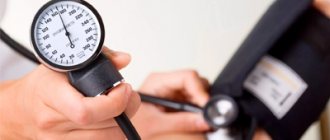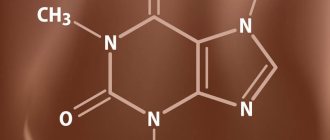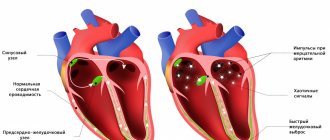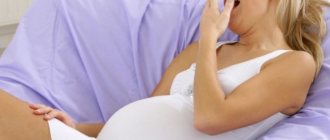Causes of heart failure
Physiological factors
Short-term discomfort in the precordial area is possible with severe fear, which is an absolutely normal situation. After eliminating the provoking factor, the unpleasant sensations disappear without a trace. Single extraordinary cardiac contractions, which are clinically manifested by freezing, are observed in 5-15% of absolutely healthy people. Their onset is provoked by nervous or physical stress, or a sudden change in weather.
Extrasystole
This type of arrhythmia most often causes the heart to freeze. Patients describe the sensation as a momentary “cardiac arrest” or talk about missing one heartbeat. Depending on the type of extrasystole, the symptom can be one-time or repeated several times in a row. The most dangerous condition is when freezing is felt in the form of regular episodes that follow every 2-3 heart beats.
The symptom is accompanied by a sharp deterioration of the condition. Patients complain of sudden dizziness, weakness, and shortness of breath. Fading of the heart during extrasystoles is characterized by a feeling of anxiety and lack of air. The skin turns pale or red. Depending on the etiological factor, extrasystole of functional, organic and toxic origin is distinguished.
Heart blocks
Heart stopping is felt during atrioventricular blockade, when the conduction of excitation from the atria to the ventricles is disrupted. With 1 degree AV block, such symptoms are observed very rarely. Small pauses in heart contractions are characteristic of 2nd degree blockade. The most pronounced freezing of heart contractions is in stage 3 disease, when the atria and ventricles work in different rhythms.
The symptom is characterized by a combination of constant weakness, decreased performance and physical activity. Freezing is accompanied by severe dizziness and shortness of breath, sometimes the attacks end in fainting. Clinical signs do not depend on the nature, activity and time of day. AV blockades occur with congenital heart defects, organic myocardial lesions, and intoxication.
Bradycardia
Fading of the heart is a common manifestation of bradycardia. The symptom, unlike extrasystoles, is not isolated, but continues for several hours or days. If a person listens to his feelings, he notices that the heart begins to beat much less often. In this case, uniform, long pauses occur between beats, which are interpreted as freezing.
Bradycardia manifests itself in a number of cardiac diseases: coronary heart disease, myocarditis and pericarditis, congenital and acquired defects. A short-term slowdown in rhythm is observed with a reflex effect - a blow to the neck or chest, being in very cold water, squeezing the neck with a tie or tight collar. Bradycardia occurs with hypothyroidism, fulminant hepatitis, and hyperkalemia.
Vegetative-vascular dystonia
With VSD, the symptom develops due to disturbances in the nervous regulation of the cardiovascular system. Freezing is more often observed during excitement, fear, and stress. Vegetative-vascular dystonia is characterized by short-term interruptions in heart function, which are then replaced by tachycardia. Symptoms are complemented by shortness of breath and weakness, dizziness, and increased sweating.
Depression
Complaints of a sinking heart are a typical symptom of a masked form of depression. Symptoms typically appear in the early morning hours. In addition to freezing, patients complain of nagging pain, discomfort, and an unreasonable feeling of fear - the so-called “precardiac melancholy.” During the day and evening, these manifestations are less intense or disappear altogether. With masked depression, other complaints are also disturbing: sleep disturbances, hypochondriacal and panic disorders.
Complications of pharmacotherapy
Many drugs used to treat cardiac patients can cause arrhythmias. Fading of the heart is often provoked by taking beta-blockers, cardiac glycosides, and diuretics. A slowdown in rhythm combined with unpleasant sensations in the heart are observed with incorrect dosage of calcium and potassium solutions, which is accompanied by the development of hyperkalemia.
Symptoms of PA
The causes of panic attacks are not exactly known. Doctors note that in 15% of cases the disorder is based on heredity. An attack can be triggered by psychogenic, biological, physiogenic factors - from troubles at work to alcohol or coffee abuse. In other words, this disorder is a reaction of the body and psyche to stress or exceeding our capabilities.
You can talk about a panic attack if you experience four or more of the following symptoms before falling asleep:
- cardiopalmus;
- sweating;
- chills, internal trembling, hot-cold;
- feeling of lack of air;
- discomfort in the left side of the chest;
- dizziness, lightheadedness;
- fear of death or fear of going crazy;
- numbness of limbs, convulsions.
Night attacks occur suddenly, often from 12 am to 4 am, reaching a peak within 10 minutes. The duration of panic is 15-30 minutes, after which the person experiences weakness, weakness, or, conversely, relief. The more severely he suffered the first attack, the more difficult it is for him to fight it further.
Diagnostics
Even if cardiac arrest is a rare episode, it is a reason to consult a cardiologist. Percussion can determine the expansion of the borders of the heart. During auscultation, muffled heart sounds and the presence of functional or organic noises are heard. To find out the cause of the symptoms, the doctor needs to obtain data from instrumental and laboratory research methods. Typically used:
- ECG.
During blockades, the ECG reveals a prolongation of the PQ interval and periodic loss of the QRS complex. Extrasystole is manifested by an extraordinary ventricular complex, after which a complete or incomplete compensatory pause occurs. Additionally, 24-hour Holter monitoring is prescribed. - EchoCG.
Ultrasound examination is necessary to find organic cardiac pathology that could cause freezing. Sonography can detect thickening of the heart wall, anatomical abnormalities, and a decrease in ejection fraction. Dopplerography is indicated to assess blood flow in the great vessels. - Biochemical tests.
Given the high prevalence of coronary artery disease, it is necessary to examine the blood lipid profile. The content of cholesterol and atherogenic LDL often increases. To exclude rheumatism and myocarditis, acute-phase blood parameters are determined - CRP, sialic acids. - Myocardial markers.
If cardiac arrest is accompanied by a serious condition of the patient and a sharp increase in symptoms, it is necessary to exclude a heart attack. For this purpose, the blood is examined for the level of troponin, myoglobin, AST and CPK enzymes. A slight increase indicates unstable angina, higher concentrations indicate myocardial necrosis. - Additional research.
If organic pathology is suspected, an MRI of the heart is performed. To identify signs of left ventricular heart failure, chest radiography is used. When cardiac arrest progresses to acute coronary syndrome, coronary angiography is performed.
Sleep disturbances in anxiety and anxiety-depressive disorders
Combination of sleep disorders and anxiety disorders
It is known that the relationship between sleep disorders and anxiety disorders is observed, on the one hand, when sleep disorders can provoke the development of anxiety disorders [5], and on the other, when the onset of an anxiety disorder precedes the onset of sleep disorders.
Complaints about problems related to sleep are typical for patients with all diseases included in the group of anxiety disorders. In the case of major generalized disorder and post-traumatic stress disorder (PTSD), sleep disturbances are one of the criteria necessary for diagnosis. There are objective reasons for the development of sleep disorders within the framework of anxiety disorders, namely: anxiety is manifested by increased cortical activation, which entails difficulty falling asleep and maintaining sleep. In the clinic, anxiety manifests itself as restlessness, irritability, motor agitation, decreased concentration, and increased fatigue [6].
The most striking manifestation of anxiety disorders is generalized anxiety disorder (GAD), which is diagnosed based on the presence of at least 3 of the following symptoms: restlessness, fatigue, difficulty concentrating, irritability, muscle tension, and sleep disturbances. The duration of the disease must be at least 6 months, the symptoms must cause psychosomatic discomfort and/or social maladjustment.
Sleep disturbances in this situation are one of the 6 diagnostic criteria for GAD. The main symptom of GAD is excessive, persistent anxiety, which is the main factor predisposing to the development of insomnia. Insomnia and GAD are closely related, usually comorbid, disorders. The difference between insomnia due to an anxiety disorder and primary insomnia not associated with other diseases is the nature of the experience during the process of falling asleep. In the case of GAD, the patient is worried about current problems [7] (work, study, relationships), which interferes with the process of falling asleep. In the case of primary insomnia, it is the disease itself that causes concern.
A polysomnographic study can reveal changes characteristic of insomnia: increased time to fall asleep, frequent awakenings, decreased sleep efficiency, and a decrease in its total duration.
Another striking example of anxiety disorders is panic disorder, which is manifested by recurrent states of severe anxiety (panic). The attacks are accompanied by phenomena of depersonalization and derealization, as well as severe autonomic disorders. The patient's behavior shows avoidance of situations in which the attack first occurred. Fear of loneliness and a recurrence of the attack are possible. A panic attack occurs spontaneously, outside of formal situations of danger or threat.
Panic disorder is more common in women and usually begins around age 20. A distinctive feature of panic disorder is spontaneous episodes of panic attacks, characterized by attacks of fear, anxiety and other vegetative manifestations. About 2/3 of patients suffering from this disorder experience some kind of sleep disturbance. Patients complain of difficulty falling asleep, non-restorative sleep, as well as characteristic nocturnal panic attacks. It should be noted that the presence of certain sleep-related problems can lead to worsening anxiety disorders, including panic disorder.
Polysomnographic testing can detect frequent awakenings, decreased sleep efficiency, and a reduction in total sleep duration [8]. It is not uncommon to observe a combination of depression and anxiety disorders, and therefore there is a possibility that the presence of other changes in sleep structure in patients with panic disorder is associated with comorbid depression, therefore it is necessary to exclude the diagnosis of depression in patients with similar sleep disorders.
Sleep paralysis, a characteristic of narcolepsy, can also occur with panic disorder. It is a motor paralysis that occurs when falling asleep or waking up, during which patients experience fear, a feeling of tightness in the chest and other somatic manifestations of anxiety. This symptom also occurs in patients with post-traumatic stress disorder.
Nocturnal panic attacks are a common occurrence in this disease [9]. They manifest themselves with a sudden awakening and all the symptoms characteristic of panic attacks. Awakening occurs during the slow-wave sleep phase, which most likely excludes their connection with dreams. It was also found that night attacks are an indicator of a more severe course of the disease. It must be remembered that patients, fearing a repetition of such episodes, deprive themselves of sleep, which leads to more serious disorders and generally reduces the quality of life of these patients.
PTSD is a disease from the group of anxiety disorders in which sleep disturbances are a diagnostic criterion. Sleep disturbances in this disease include 2 main symptoms: nightmares and insomnia. Other phenomena inherent in PTSD and associated with sleep are: somnambulism, sleep talking, hypnagogic and hypnopompic hallucinations. The changes detected by polysomnography are not specific and in some cases may be absent. Possible changes include: an increase in the representation of the 1st stage of sleep, a decrease in the representation of the 4th stage of sleep. Also, with PTSD, breathing disorders during sleep are often found.
Agoraphobia, which is defined as anxiety that arises in response to situations from which, in the patient’s opinion, is difficult to escape, can also be a manifestation of anxiety disorders. In the clinical picture, as a rule, there is a persistent fear of the patient being in crowded places, public places (shops, open squares and streets, theaters, cinemas, concert halls, workplaces), fear of independent long trips (on various types of transport). The situational component of agoraphobia syndrome is expressed in the confinement of phobic experiences to certain situations and in the fear of getting into situations in which, according to patients, a repetition of painful sensations is likely. Often agoraphobic symptoms cover many fears of various situations, forming panagoraphobia - fear of leaving the house with the development of deep social maladaptation. The patient's attempts to overcome his own experiences are observed; in unfavorable cases, social activities are limited.
Specific phobias are characterized by the connection of anxiety with certain situations (air travel, contact with animals, the sight of blood, etc.), also accompanied by an avoidance reaction. Patients are critical of their experiences, however, phobias have a significant impact on various areas of the patients’ activities. The following forms are found: cardiophobia, cancerophobia, claustrophobia, etc. Sleep disturbances in these patients are nonspecific, and from the patient’s point of view they are a minor manifestation of the disease.
In general, the most common manifestations of sleep disorders in anxiety states are presomnia disorders. The initial phase of sleep consists of 2 components: drowsiness, a kind of desire to sleep, and falling asleep itself. Often, patients have no desire to sleep, no desire to sleep, muscle relaxation does not occur, and they have to perform various actions aimed at falling asleep. In other cases, the desire to sleep is present, but its intensity is reduced, and drowsiness takes on an intermittent, wave-like character. Drowsiness occurs, muscles relax, perception of the environment decreases, the patient takes a comfortable position for falling asleep, and a slight drowsy state appears, but soon it is interrupted, disturbing thoughts and ideas arise in the mind. Subsequently, the state of wakefulness is again replaced by slight drowsiness and superficial drowsiness. Such changes in states can be repeated several times, leading to emotional discomfort that prevents the onset of sleep.
In a number of patients, worries about disturbed sleep can acquire an overvalued-hypochondriacal coloring and, according to the mechanisms of actualization, come to the fore; often an obsessive fear of insomnia arises - agripnophobia. It is usually combined with an anxious and painful expectation of sleep, certain demands on others and the creation of the special conditions noted above for sleep.
Anxious depression is characterized by the patient's constant experience of anxiety, a sense of impending threat and uncertainty. Anxious experiences change: worry about your loved ones, fears about your condition, your actions. The structure of anxious depression, as a rule, includes anxious fears, feelings of guilt, motor restlessness, fussiness, fluctuations in affect with worsening in the evening hours, and somatovegetative symptoms. Anxious and melancholy affects often occur simultaneously; in many cases it is impossible to determine which of them is leading in the patient. Anxious depression most often occurs in people of involutionary age and occurs in protracted phases. In addition, it is actually the leading type of depression of the neurotic level [10].
The patient exhibits a variety of symptoms of anxiety and depression. Initially, one or more somatic symptoms may be detected (for example, fatigue, pain, sleep disturbances). Further questioning reveals depression and/or anxiety.
Signs of anxious depression:
- low mood;
- loss of interests;
- pronounced anxiety.
The following symptoms are also often detected:
- sleep disorders;
- physical weakness and loss of energy;
- fatigue or decreased activity;
- difficulty concentrating, fussiness;
- impaired concentration;
- agitation or inhibition of movements or speech;
- appetite disorders;
- dry mouth;
- tension and anxiety;
- irritability;
- tremor;
- heartbeat;
- dizziness;
- suicidal thoughts.
Often with anxious depression, variants of presomnia disorders are observed, in which the desire to sleep is pronounced, drowsiness increases quickly, and the patient falls asleep relatively easily, but after 5–10 minutes he suddenly wakes up, drowsiness completely disappears, and then for 1–2 hours he does not can fall asleep. This period without sleep is characterized by unpleasant ideas, thoughts, fears, reflecting, to a greater or lesser extent, the experienced conflict situation and the reaction to the inability to sleep. Hyperesthesia to sensory stimuli is also observed. Those suffering from this form of sleep disorder react extremely painfully to the slightest sensory stimuli, even outbursts of passion.
Disturbed sleep patterns are characterized by a prolongation of the drowsy period. This drowsy state is often accompanied by motor, sensory and visceral automatisms, sharp shudders, vivid perceptions of sounds and visual images, palpitations, and sensations of muscle spasms. Often these phenomena, awakening the patient, cause various painful ideas and fears, sometimes acquiring an obsessive character.
Sleep disorders and their polysomnographic manifestations among mental illnesses have been most studied for depressive disorder. Among the sleep disorders associated with depressive disorder, the most common is insomnia. The severity and duration of insomnia are manifestations of a more severe depressive disorder, and the appearance of insomnia during remission indicates the imminent occurrence of a repeated depressive episode [1]. In addition, sleep disorders in this disease are the most persistent symptom. The close relationship of this disorder with sleep disorders is explained by the biochemical processes characteristic of depression. In particular, in depressive disorder there is a decrease in the level of serotonin, which plays a role in initiating REM sleep and organizing delta sleep [11]. Depressive disorder is characterized by the following manifestations of sleep disturbances: difficulty falling asleep [10], non-restorative sleep, and, as a rule, reduced total sleep time. The most specific symptoms for depression are frequent awakenings at night and early terminal awakening. Complaints of difficulty falling asleep are more often observed in young patients, and frequent awakenings are more common in older patients [12].
With masked depression, complaints of sleep disturbances may be the only manifestation of the disease. With depression, in contrast to primary insomnia, there are complaints of sleep disturbances that are typical for this disease: frequent awakenings, early morning awakening, etc. [12].
In a polysomnographic study, the following changes are observed: an increase in the time it takes to fall asleep, a decrease in sleep efficiency. The most common symptoms specific to depressive disorder are shortened REM sleep latency and decreased delta sleep. It has been found that patients with a higher proportion of delta sleep remain in remission longer compared to patients who experience a decrease in the proportion of delta sleep [13].
Attempts have been made to explore the possibility of using depression-specific sleep disturbances as markers of depressive disorder. Due to the heterogeneity of the manifestations of sleep disorders, this issue remains not fully resolved.
The characteristics of sleep disturbances in various types of depression were also highlighted. Patients with a predominance of the anxiety component are more likely to have difficulty falling asleep and early awakenings. With this type of depression, dream plots are associated with persecution, threats, etc. In addition, these patients generally had a high level of wakefulness before falling asleep. For depression with a leading affect of melancholy, early morning awakenings and dreams of static types of gloomy content are most characteristic. Depression with apathy affect is characterized by early awakenings and rare, unsaturated dreams. Also typical for depression with apathetic affect is the loss of the sense of boundaries between sleep and wakefulness. Patients with bipolar disorder have a similar polysomnographic picture [14].
Features of sleep disturbance in bipolar disorder are a significant decrease in sleep duration during a manic episode and a greater tendency of patients to hypersomnia during depressive episodes compared to the unipolar course of the disorder. There are usually no complaints of sleep disturbances during manic episodes.
Treatment
For the treatment of anxiety and depressive disorders, drugs of various pharmacological groups are used: tranquilizers (mainly long-acting or short-acting benzodiazepine drugs), selective serotonin reuptake inhibitors, selective serotonin reuptake stimulants, tricyclic antidepressants. All of these drugs, to one degree or another, affect a person’s sleep, making it easier to fall asleep, reducing the number and duration of night awakenings, thereby affecting the recovery processes that occur during night sleep. When developing tactics for treating sleep disorders combined with anxiety and depressive symptoms, it is important to remember that insomnia itself can increase anxiety, worsen well-being, and mood, usually in the morning after poor sleep [15]. In this regard, the use of hypnotics in treatment may be promising if insomnia symptoms are predominant in the clinical picture in order to prevent exacerbation of anxiety and depressive disorders. In this regard, the most effective assistants can be hypnotics that affect the GABAergic (GABA - γ-aminobutyric acid) system - histamine receptor blockers (Valocordin®-Doxylamine) and melatonin preparation. The most convenient to use in the treatment of insomnia is Valocordin®-Doxylamine, which is available in drops, which allows you to select an individual dose of the drug.
Valocordin®-Doxylamine is a unique drug used as a hypnotic. Most of the known hypnotic drugs (benzodiazepines, cyclopyrrolones, imidazopyridines, etc.) act on the GABAergic complex, activating the activity of somnogenic systems, while histamine receptor blockers act on the waking systems, not sleep, reducing their activation. A fundamentally different mechanism of hypnotic action allows Valocordin®-Doxylamine to be used more widely: when changing one drug to another, reducing the dosage of “habitual hypnotics,” as well as when it is necessary to discontinue hypnotics.
A study of the drug in healthy subjects showed that doxylamine succinate leads to a decrease in the duration of night awakenings and stage 1 sleep and an increase in stage 2 sleep without a significant effect on the duration of the 3rd and 4th stages of sleep and REM sleep. There was no significant subjective effect on the reports of healthy volunteers; however, compared with placebo, doxylamine increased the depth of sleep and improved its quality [16].
In Russia, one of the first studies was carried out under the leadership of A.M. Wayne [17]. It has been shown that under the influence of doxylamine, such subjective characteristics of sleep as the duration of falling asleep, the duration and quality of sleep, the number of night awakenings and the quality of morning awakening improve. Analysis of objective sleep characteristics showed that while taking doxylamine, there is a reduction in the time of wakefulness during sleep, a decrease in the duration of falling asleep, an increase in sleep duration, REM sleep phase time, and the sleep quality index. It was also shown that doxylamine did not reduce the effectiveness of the use of other drugs in patients, such as antihypertensive, vasoactive, etc. The results of a study of the effect of doxylamine on patients with insomnia indicate the effectiveness of this drug in these patients. Subjective feelings of a positive effect are confirmed by objective studies of the structure of sleep, which is undergoing positive changes, which affect indicators such as sleep duration, duration of falling asleep, REM sleep phase. Of great importance is also the absence of any changes in the results of questionnaire data regarding drowsiness and sleep apnea syndrome, which indicates the absence of an aftereffect of the drug in relation to the worsening of obstructive apnea syndrome. However, if obstructive sleep apnea is suspected, doxylamine should be prescribed with caution.
Modern clinical studies do not reveal serious side effects when treated with therapeutic doses of the drug, but it is always necessary to remember the possible appearance of symptoms that arise due to the individual characteristics of the body, and contraindications (glaucoma; difficulty urinating due to benign prostatic hyperplasia; age under 15 years; increased sensitivity to the drug).
Simultaneous use of the drug Valocordin®-Doxylamine and sedatives that affect the central nervous system (CNS): antipsychotics, tranquilizers, antidepressants, hypnotics, analgesics, anesthetics, antiepileptics, may enhance their effect. Procarbazines and antihistamines should be combined with caution to minimize CNS depression and possible drug potentiation. During treatment with Valocordin®-Doxylamine, alcohol should be avoided as it may unpredictably interfere with the effects of doxylamine succinate.
While using this drug, it is recommended to avoid driving a car and operating machinery, as well as other activities accompanied by an increased risk, at least in the first stage of treatment. It is recommended that the attending physician evaluate the individual reaction rate when choosing a dose. These features of the drug’s influence are important to consider when treating patients with insomnia in order to increase the effectiveness of the drug Valocordin®-Doxylamine and eliminate possible undesirable effects.
Conclusion
When diagnosing the disease, it is important to remember that, as a rule, problems falling asleep indicate the presence of severe anxiety, early awakenings are a manifestation of depression. When choosing treatment tactics at all stages of the development of anxiety-depressive syndrome (ADS), the prescription of modern sleeping pills at the stage of unexpressed ADS is a promising tactical approach aimed at reducing the risk of further increase in symptoms of anxiety and depression.
Treatment
Help before diagnosis
When heart palpitations occur, a person needs to immediately sit down and take a comfortable position. In case of rare heart contractions, it is better to lie on your back with your legs slightly elevated. It is necessary to provide access to fresh air by opening windows or doors. Usually the state of health returns to normal within a few minutes. If the patient feels worse, complains of pain in the precardiac region or fainting, emergency medical attention is required.
Conservative therapy
Effective treatment can begin only after the causes of cardiac arrest have been established. Patients with severe illness receive intensive parenteral therapy in the hospital or intensive care unit, but in most cases outpatient treatment is sufficient. To eliminate the root cause of the symptom, normalize heart function and regulate the heart rate, the following is prescribed:
- Antiarrhythmic drugs.
In the arsenal of cardiologists there are 4 classes of drugs that are indicated for arrhythmias. They start with monotherapy, but if high doses of drugs are ineffective or intolerable, the optimal result is shown by a combination of 2-3 drugs. - Beta adrenergic agonists.
The drugs improve conductivity and increase heart rate in patients with atrioventricular block. Medicines are used in short courses. If therapy is ineffective, pacemaker installation is considered. - Anti-inflammatory drugs.
For myocarditis and rheumatic diseases, NSAIDs are recommended, which reduce inflammatory damage to the myocardium. In severe systemic processes, it is advisable to treat with glucocorticoids. - Metabolic agents.
Antihypoxants and antioxidants are widely used, which improve myocardial function in conditions of insufficient blood supply and prevent free radical oxidation. To increase the contractility of the heart muscle, ATP drugs are administered.









